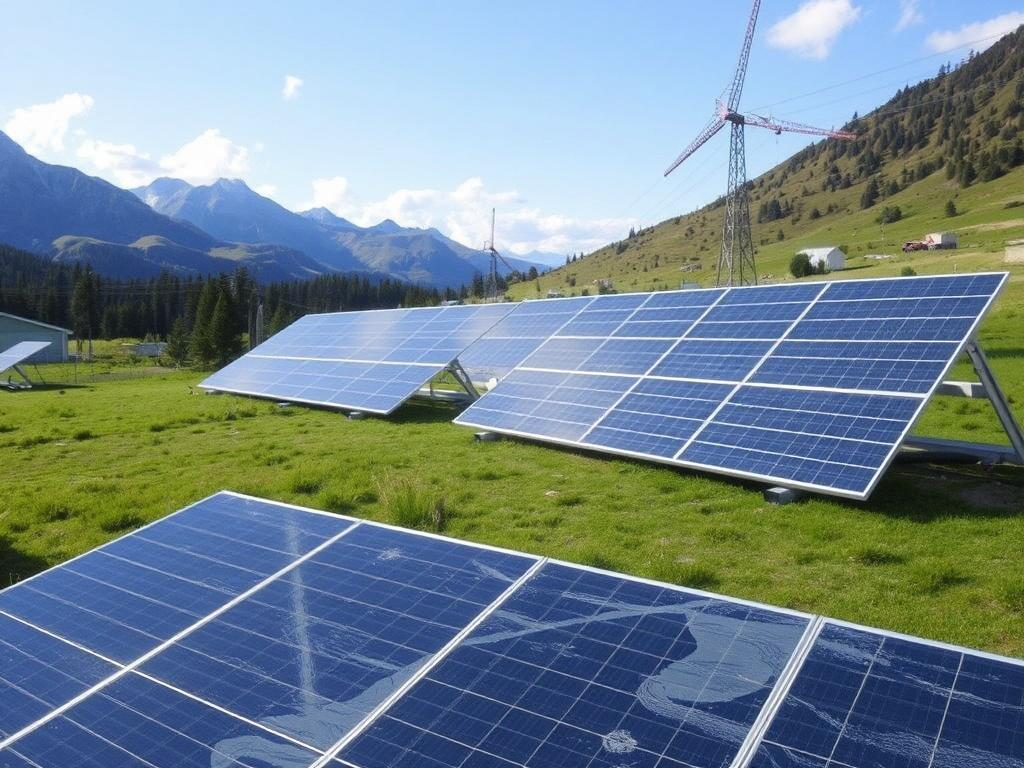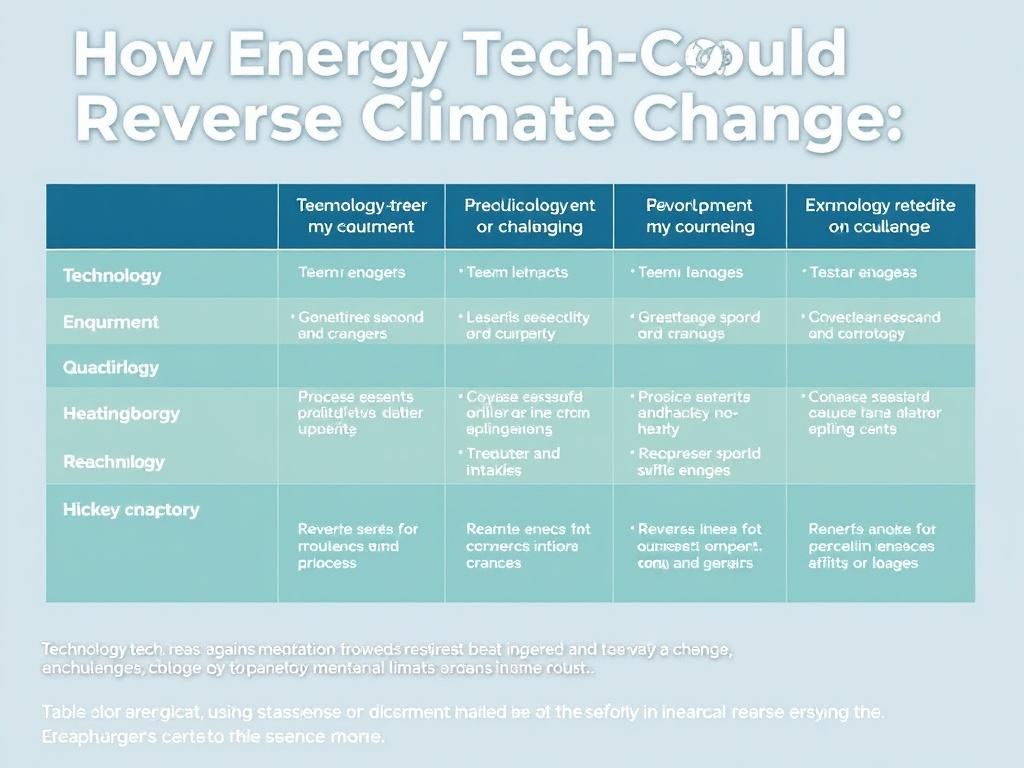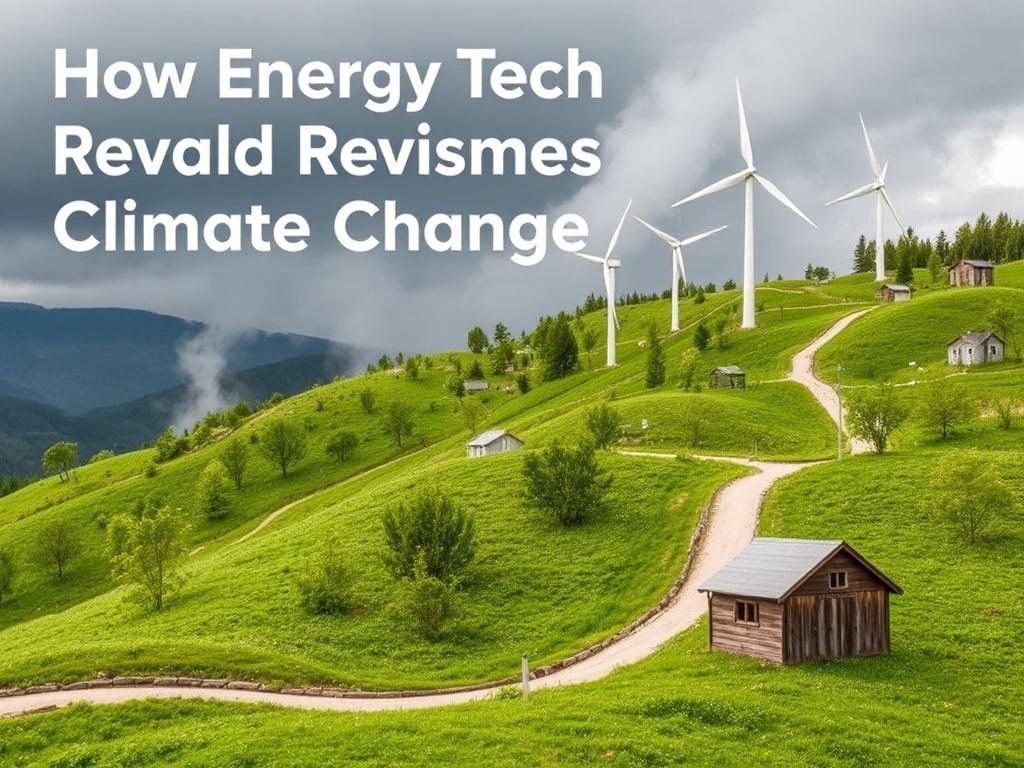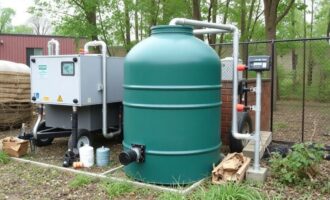- Why energy tech matters now
- Core energy technologies that can drive reversal
- Renewable generation: wind, solar, geothermal, and more
- Energy storage: batteries, long-duration storage, and thermal storage
- Electrification of transport and heating
- Green hydrogen and electrified industrial processes
- Nuclear and advanced fission/fusion concepts
- Carbon removal: taking carbon out of the atmosphere
- Tree planting and nature-based solutions
- Bioenergy with carbon capture and storage (BECCS)
- Direct air capture (DAC) and engineered solutions
- Enhanced weathering and mineralization
- How these pieces fit together: an integrated systems perspective
- Electricity first, then end-use electrification
- Storage and flexibility enable high renewable shares
- Carbon removal deals with historical emissions and residuals
- Policy as the catalyst
- Table: Technology snapshot — readiness, impact, and key challenges
- Scaling and economics: how costs will fall
- Policy, regulation, and finance: the enablers of transformation
- Demand creation
- Infrastructure and planning
- Governance and standards
- Social dimensions: equity, jobs, and public acceptance
- Risks, trade-offs, and how to manage them
- Myths and misconceptions
- Practical roadmap: what to do in the next 5, 10, and 30 years
- Next 5 years (now through near-term)
- Next 10 years
- Next 30 years
- Who needs to act and how you can contribute
- Simple actions you can take today
- Measuring success: metrics and monitoring
- Case studies: early wins and lessons learned
- Community solar plus storage
- Green steel pilot
- Direct air capture and geological storage demonstration
- Looking ahead: scenarios for reversal
- Conclusion
Climate change feels like a slow-moving storm that we can see coming but haven’t fully learned to outrun. Yet, tucked inside the challenge are extraordinary opportunities: smart energy technologies, new chemistry, better machines, and smarter systems could, if combined and scaled, not only stop emissions but actually reverse parts of the warming trend. This article walks you through how energy tech—across power generation, storage, transport, industry, and carbon removal—could create that reversal. I’ll explain the tools, the obstacles, how they fit together, and the policy and social action needed to turn innovation into real-world climate outcomes. No dense academic prose; just an honest, step-by-step discussion that you can follow and use to form practical expectations.
Why energy tech matters now
The physics is simple: burning fossil fuels releases carbon dioxide and other greenhouse gases; those gases trap heat; the planet warms. Energy systems—power plants, factories, cars, ships, and buildings—are the dominant sources of those emissions. That means changing how we produce, store, use, and manage energy is the fastest lever for big climate impact. Technological change in the energy sector can reduce emissions at scale and create pathways to actively remove carbon from the atmosphere. Because energy technologies interact with economics, policy, and society, they have the power to change behavior and markets fast—if the right conditions are in place.
But “reversal” is a demanding word. It doesn’t mean we’ll instantly roll global temperatures back to preindustrial levels. What energy tech offers is a credible route to stop new emissions and pull excess carbon out of the atmosphere over decades—enough to stabilize the climate and reduce risks. Let’s dig into how that could happen.
Core energy technologies that can drive reversal
The technologies can be grouped into three broad categories: emissions avoidance (replace carbon-intensive activities), emissions reduction (use energy more efficiently), and carbon removal (take carbon out of the air permanently). All three must scale massively.
Renewable generation: wind, solar, geothermal, and more
Solar and wind have been the headline performers of the last decade. Costs have fallen dramatically; deployment has scaled into the terawatt range. These are foundational because they replace coal, oil, and gas in electricity generation—the largest single source of emissions. Geothermal, tidal, and concentrated solar power add diversity where geography allows.
Adoption checklist:
- Increase grid-connected capacity and diversify locations to smooth output.
- Pair renewables with storage and flexible demand so they can meet 24/7 needs.
- Streamline permitting and grid interconnection to avoid deployment bottlenecks.
Energy storage: batteries, long-duration storage, and thermal storage
Batteries (lithium-ion and emerging chemistries) enable renewables to act like dispatchable power. Long-duration energy storage—flow batteries, compressed air, hydrogen storage, and advanced thermal systems—are necessary for seasonal balancing and for smoothing weeks of low wind or sun. As costs decline and manufacturing scales, storage will unlock deeper renewables penetration.
Key considerations:
- Scale up diverse storage technologies to cover short and long durations.
- Build recycling and resource recovery systems for battery materials.
- Invest in grid planning that values storage as a resource for reliability and resilience.
Electrification of transport and heating
Switching from combustion to electric vehicles (EVs) and heat pumps is one of the most direct ways to reduce energy-sector emissions—provided the electricity comes from low-carbon sources. EV adoption also supports flexible load that can help integrate renewables (vehicle-to-grid concepts). Heat pumps for buildings reduce gas use and are highly efficient.
Practical steps:
- Electrify public transit and freight where feasible.
- Offer incentives and retrofit programs for heat pump adoption in buildings.
- Improve grid capacity and charging infrastructure planning to handle increased electric loads.
Green hydrogen and electrified industrial processes
Some industrial processes—steelmaking, chemical feedstocks, heavy transport—are hard to electrify. Green hydrogen (hydrogen produced using renewable electricity) and electrification with high-temperature heat technology are critical. Hydrogen can also be a storage medium, feedstock, and fuel for shipping and aviation when used in low-carbon forms.
Challenges and approaches:
- Scale renewable electricity dedicated to hydrogen production.
- Demonstrate low-emissions hydrogen in steel and chemicals at commercial scale.
- Create markets and procurement pathways to lower green hydrogen costs through demand certainty.
Nuclear and advanced fission/fusion concepts
Nuclear power provides reliable, low-carbon baseload power. Advanced small modular reactors (SMRs) and emerging fusion concepts offer potential for safer, more flexible nuclear deployment. While nuclear has high upfront costs and social complexity, it’s an important option where renewables and storage alone are challenging.
Deployment pointers:
- Invest in research and demonstration for SMRs and fusion where appropriate.
- Address regulatory frameworks to maintain safety while reducing unnecessary delays.
- Consider nuclear as part of a diverse portfolio rather than a single solution.
Carbon removal: taking carbon out of the atmosphere
To reverse climate change meaningfully, we need not only to stop new emissions but remove past emissions. Several carbon dioxide removal (CDR) techniques show promise; each has trade-offs in cost, scale, permanence, land use, and readiness.
Tree planting and nature-based solutions
Reforestation, afforestation, wetland restoration, and soil carbon sequestration are immediate and lower-cost options that provide co-benefits—biodiversity, water regulation, and livelihoods. They can store carbon for decades to centuries, though permanence is vulnerable to fire, pests, and land-use change.
Best practices:
- Prioritize restoration of native ecosystems and avoid monoculture plantations with weak biodiversity value.
- Pair carbon accounting with community stewardship and legal protections to improve permanence.
- Combine with emission reductions; don’t use nature-only approaches as an excuse to delay decarbonization.
Bioenergy with carbon capture and storage (BECCS)
BECCS burns biomass for energy and captures the CO2 emitted, storing it underground. If managed sustainably, BECCS can be net-negative because the biomass removed CO2 from the atmosphere while growing. It’s technically plausible but requires large sustainable biomass supplies and reliable storage.
Caveats:
- Ensure biomass sourcing doesn’t compete with food or natural ecosystems.
- Develop transparent sustainability criteria for feedstocks.
- Scale CCS transport and storage infrastructure to support multiple sites.
Direct air capture (DAC) and engineered solutions
Direct air capture uses chemical processes to pull CO2 directly from ambient air. Once captured, CO2 can be stored geologically or used in long-lived products. DAC is energy-intensive but modular and location-independent; it can deliver permanent removal when paired with secure storage.
Scaling issues:
- Reduce energy and materials costs through learning-by-doing and industrial-scale deployment.
- Pair DAC with low-carbon energy sources to avoid counterproductive emissions.
- Expand CO2 transport and storage capacity with proper monitoring and liability frameworks.
Enhanced weathering and mineralization
Enhanced weathering spreads crushed silicate rocks on land or in the ocean to accelerate natural carbon uptake through chemical reactions that form stable carbonates. Mineralization—reacting CO2 with rocks to permanently lock it as solid carbonates—is another pathway. These processes have huge theoretical capacity but require mining, grinding, and careful environmental assessment.
Considerations:
- Evaluate lifecycle impacts of mining and transport to ensure net removal.
- Begin with pilot programs and monitoring of ecological impacts.
- Integrate with co-benefits like soil health improvements where possible.
How these pieces fit together: an integrated systems perspective

Tech fragments are useful, but the real power lies in systems thinking. To reverse climate change, technologies must be integrated into energy, industrial, transport, and land systems—financed by markets and governed by policy. Here’s how the pieces interact:
Electricity first, then end-use electrification
A zero-carbon electricity system is the backbone. Once power is decarbonized, transport, heating, and industry can increasingly be electrified, multiplying emissions reductions. Think of electricity as the vector that transports renewables’ low-carbon character into everyday uses.
Storage and flexibility enable high renewable shares
High shares of wind and solar must be matched with storage, flexible demand (like EV charging schedules), and regional interconnections. Smart grids and digital control systems harmonize variable supply and shifting demand.
Carbon removal deals with historical emissions and residuals
Even a near-zero-emissions energy system will leave residual emissions—hard-to-abate industrial processes, some transport modes, and methane leaks. CDR can compensate for those residuals and draw down legacy emissions, aiming over decades to reach net-negative outcomes.
Policy as the catalyst
Technologies scale when policy reduces risk and creates demand. Carbon pricing, procurement targets, renewable mandates, tax incentives, and infrastructure investment are the levers that make industries confident to build factories and pipelines at scale.
Table: Technology snapshot — readiness, impact, and key challenges

| Technology | Primary role | Readiness | Potential CO2 impact | Key challenge |
|---|---|---|---|---|
| Solar PV | Clean electricity | High | Large (displaces fossil power) | Grid integration, material supply chains |
| Onshore Wind | Clean electricity | High | Large | Site permitting, social acceptance |
| Battery storage (Li-ion) | Short/medium-duration storage | High | Enables renewables (significant indirect) | Resource recycling, raw materials |
| Long-duration storage (varied) | Seasonal balancing | Medium | Enables higher renewables penetration | Cost and demonstration at scale |
| Heat pumps | Heating electrification | High | Large in buildings | Retrofitting costs and consumer awareness |
| Green hydrogen | Feedstock, fuel, storage | Low-medium | High if deployed in industry/freight | Cost of electrolysis and renewable power allocation |
| Direct air capture | Carbon removal | Low-medium | Potentially large with scale | Energy intensity and cost |
| BECCS | Carbon removal + energy | Low-medium | Large if sustainable biomass available | Land use and feedstock sustainability |
| Enhanced weathering | Carbon removal | Low | Very large potential | Mining, transport, ecological impacts |
| Advanced nuclear (SMRs) | Low-carbon baseload | Medium | Significant | Cost, licensing, social acceptance |
Scaling and economics: how costs will fall
Cost decline matters because cheaper tech scales faster. Historically, solar PV and batteries have shown that learning-by-doing and manufacturing scale can cut costs by 20–30% for each doubling of capacity. Similar dynamics can apply to electrolyzers for hydrogen, DAC units, and modular nuclear if early markets are created.
Ways to accelerate cost declines:
- Market pull: procurement and long-term contracts (power purchase agreements, offtake for hydrogen and carbon removal).
- Public investment in demonstration projects and first-of-a-kind plants to prove technologies at scale.
- Standardization and mass manufacturing to reduce capital and labor costs.
- Supply chain investment, including mining, refining, and recycling infrastructure.
Economic framing should include co-benefits: health improvements from reduced air pollution, energy security, job creation, and innovation clusters that strengthen local economies.
Policy, regulation, and finance: the enablers of transformation
Technology alone won’t reverse climate change. Policies and money steer where technologies get built and who benefits. Three policy fronts are essential: demand creation, infrastructure, and governance.
Demand creation
Governments and major buyers can create markets for new tech:
- Carbon pricing or emissions standards to make dirty options more expensive.
- Procurement mandates—e.g., low-carbon steel for public projects.
- Tax credits and subsidies for first movers, especially in carbon removal and green hydrogen.
Infrastructure and planning
Large-scale deployment needs physical systems:
- Grid expansion and modernization to handle renewables and electrified loads.
- CO2 transport (pipelines) and storage sites certified and permitted for CCS/DAC outputs.
- Ports, hydrogen refueling networks, and EV charging networks to decarbonize transport.
Governance and standards
Trust and transparency are crucial, especially for carbon removal:
- Standards for carbon accounting and permanence across nature-based and engineered removals.
- Monitoring, reporting, and verification (MRV) systems to ensure real emissions reductions.
- Clear liability rules for storage and long-term stewardship responsibilities.
Finance will need to evolve: public capital de-risks private investment in early stages, green bonds fund infrastructure, and blended finance helps deploy solutions in developing economies. Carbon markets can mobilize funds for removal, but they must be robust to prevent greenwashing.
Social dimensions: equity, jobs, and public acceptance
Technological pathways only succeed if they are socially acceptable and equitable. A just transition ensures workers and communities dependent on fossil industries are supported with retraining, income support, and new economic opportunities. Local benefits—clean air, lower energy bills, jobs—build public buy-in.
Key social actions:
- Design transition policies with affected workers and communities at the table.
- Use public investments to target regions with job losses from fossil phase-outs.
- Prioritize community-scale renewables and ownership models to spread benefits.
Risks, trade-offs, and how to manage them
Every path has trade-offs. Large-scale bioenergy may compete with food or biodiversity. Mineral extraction for batteries can harm local environments if poorly regulated. Rapid deployment without proper siting can fuel opposition. Carbon removal technologies may be energy-intensive and expensive. Policymakers and planners must weigh these trade-offs and use adaptive management.
How to manage risks:
- Build robust environmental and social safeguards into projects.
- Invest in recycling and circular supply chains to reduce raw material pressures.
- Keep aggressive emissions reductions first—don’t rely solely on future removal technologies.
- Prioritize co-benefits and multifunctional solutions that solve several problems at once (e.g., wetland restoration for flood protection and carbon storage).
Myths and misconceptions
It’s worth busting a few myths that get in the way of constructive action:
- Myth: One technology will save us. Reality: No single technology suffices; we need portfolios and system integration.
- Myth: Carbon removal means we can keep burning fossil fuels. Reality: Removal complements deep emissions cuts, it does not replace them.
- Myth: Reversal is immediate. Reality: Reversal is multi-decade and requires sustained effort across technology, policy, and society.
Practical roadmap: what to do in the next 5, 10, and 30 years

If you want a practical timeline for action, here’s a high-level roadmap that combines technology deployment, policy, and social measures.
Next 5 years (now through near-term)
- Rapidly scale renewables and battery manufacturing capacity. Streamline permitting processes and invest in grid upgrades.
- Deploy heat pumps and EV infrastructure with incentives targeted at low-income households to avoid unequal access.
- Finance first commercial-scale DAC and BECCS demonstrations to drive learning.
- Create clear standards and MRV systems for carbon credits and removals to create trustworthy markets.
Next 10 years
- Reach high renewable shares on grids with diversified storage and regional interconnections.
- Decarbonize industry with green hydrogen pilots and electrified processes moving into commercial phases.
- Scale proven carbon removal solutions where cost and permanence are clear, and begin cross-border CO2 transport planning.
- Introduce stronger carbon pricing and procurement mandates to lock in demand for low-carbon materials.
Next 30 years
- Aim for net-negative emissions by coupling near-zero emissions energy systems with scaled carbon removal—resulting in declining atmospheric CO2 concentration trends.
- Ensure robust global cooperation on CO2 accounting, finance, and technology transfer so all countries can participate in removal and decarbonization.
- Institutionalize long-term monitoring and stewardship of stored carbon, and mature recycling and circular industries to minimize new resource extraction.
Who needs to act and how you can contribute
Governments, businesses, researchers, communities, and individuals all have roles:
- Governments: Set rules, invest in infrastructure, and create markets that reward low-carbon options.
- Businesses: Commit to science-based targets, invest in low-carbon supply chains, and collaborate to scale technologies.
- Researchers: Improve efficiency and cost profiles of key technologies and study system impacts and safeguards.
- Communities: Engage in planning to ensure local benefits and hold projects accountable to environmental and social standards.
- Individuals: Reduce personal emissions where possible, support equitable policies, vote, and participate in community energy projects.
Simple actions you can take today
- Choose green electricity or community solar where available.
- Switch to efficient electric appliances and consider an EV when it’s time to replace your car.
- Support policies and businesses that push toward deep decarbonization and transparent carbon removal.
Measuring success: metrics and monitoring
Reversal needs accountability. Measures to track progress include:
- Global and national greenhouse gas inventories updated annually.
- Installed capacity of renewables and storage, plus grid emissions intensity (gCO2/kWh).
- Scale of deployed carbon removal (tonnes CO2/year), permanence metrics, and verified storage sites.
- Socioeconomic indicators: jobs in clean energy, just transition measures, and distribution of benefits across communities.
Effective monitoring relies on transparent data sharing, publicly available project-level performance, and third-party verification.
Case studies: early wins and lessons learned
A few practical examples illustrate how projects can combine technologies, policy, and social engagement:
Community solar plus storage
In multiple regions, community-owned solar farms paired with battery storage have lowered electricity bills, provided local jobs, and stabilized the grid during outages. Key lesson: local ownership increases acceptance and ensures benefits stay local.
Green steel pilot
Steelmakers experimenting with hydrogen-based direct reduced iron show that emissions-intensive sectors can decarbonize if there’s coordinated demand and policy support (e.g., public procurement for low-carbon steel). Key lesson: early government contracts reduce market risk and accelerate investment.
Direct air capture and geological storage demonstration
Commercial DAC facilities paired with secure geological storage have proven the technical chain from capture to permanent storage. Key lesson: scaling reduces unit cost, but policy incentives are needed to achieve first-mover economics.
Looking ahead: scenarios for reversal
Models show a range of possible futures. The most credible reversal scenarios share some features:
- Rapid electrification powered by low-carbon electricity.
- Widespread deployment of energy storage and grid modernization.
- Large-scale carbon removal (both nature-based and engineered) to draw down legacy CO2.
- Strong international cooperation, finance flows, and just transition policies.
If these elements align, the global carbon budget can shift from net-positive emissions to net-negative within decades, making gradual reversal of atmospheric CO2 concentrations feasible. Importantly, the speed of progress determines how much warming is avoided, and faster action yields bigger safety margins against climate extremes.
Conclusion
Energy technologies give us a realistic path to not just slow climate change but to begin reversing its course—if we combine fast, deep emission cuts with large-scale carbon removal, backed by smart policy, finance, and social commitment. The recipe is not a single silver bullet; it’s a portfolio: massive renewables and storage, electrification, green hydrogen where needed, advances in nuclear where appropriate, and durable carbon removal options that together reduce and then draw down atmospheric CO2. Scaling these tools will require coordinated public action—clear rules, infrastructure investment, and markets that reward climate benefit—while protecting communities and ecosystems through strong safeguards and a just transition. The task is immense, but so is the human capacity to innovate and cooperate; with ambition, urgency, and wise governance, energy tech can help turn a warming world toward recovery.
Как вам статья?







